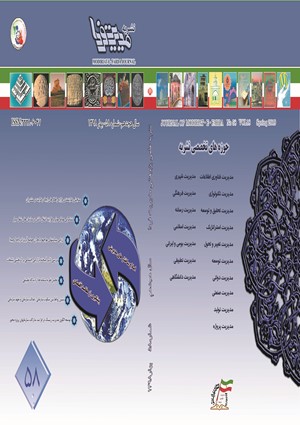The Effect Of Customer Knowledge Management Performance With Moderating Role Of Innovation Capability In Insurance Industry : A Case Study On Alborz Insurance Company
Subject Areas :
nasrin talaeefard
1
,
Farhad Sanjarifard
2
![]() ,
nader salehi
3
,
nader salehi
3
![]()
1 -
2 - Islamic azad university
3 -
Keywords: Customer Knowledge Management, Business Performance, Innovation, Insurance Industry,
Abstract :
Abstract The general objective of this research is to identify the effects of customer knowledge flows on the performance and dimensions of innovation in organizations and to illustrate some of the important benefits of knowledge flows of customers in organizations. Which benefits from the interaction between the external and internal environment and brings unique privileges to the organization. This research is descriptive-correlational. In this research, after identifying the factors and dimensions and indicators of variables, a researcher-made questionnaire was designed based on the Likert spectrum and distributed among 200 managers of the Alborz Insurance Company. Then performance measures and customer knowledge management, business innovation and business were categorized using structural equation analysis. Finally, the research model was evaluated using PLS software. The results of the research showed that customer knowledge management has an impact on business performance with mediating the ability to innovate in the insurance industry.
منابع فارسی 1. حیدر.علی. هومن(1392) مدلیابی معادلات ساختاری با استفاده از نرم افزار لیزرل، تهران انتشارات سمت.
2. الماسی، حسن (1384) ،نگرش جديد در مديريت منابع انساني از ارزيابي عملكرد تا مديريت عملكرد، تدبير شماره 86
3. اسماعیل پور، رضا. دوستار، محمد. طاهر پرور، نسترن.(1393). مدیریت دانش مشتری و نقش آن در نوآوری مستمر و عملکرد برتر (مطالعه موردی بانک های خصوصی سطح استان گیلان). نشریه مدیریت بازرگانی دانشگاه تهران
منابع انکلیسی 1. Ramaswami, S. N., rivastava, R. K. & Bhargava, M. (2009). Market-based capabilities and financial performance of firms: Insights into marketing’s contribution to firm value, Journal of the Academy of Marketing Sciences, 37(2): 97- 116.
2. Nonaka, I., Toyama, R. & Konno, N. (2000). SECI, Ba and leadership: A unified model of dynamic knowledge creation, Long Range Planning, 33(1): 5– 34.
3. Paquette, Scott. (2006) "Customer knowledge management." Encyclopedia of Knowledge Management: 90.
4. Von Hippel, E. (1986). Lead user: A source of novel product concepts, Management Science, 32(7): 791- 805.
5. Jonas Matthing, Bodil Sandén, Bo Edvardsson(2004) New service development: learning from and with customers International Journal of Service Industry Management
6. S Nambisan, RA Baron - Journal of product innovation management, 2009 Virtual customer environments: testing a model of voluntary participation in value co‐creation activities Journal of product innovation management 388-406
7. Campbell, A. J. (2003). Creating customer knowledge competence: Managing customer relationship management programs strategically, Industrial Marketing Management, 32(5): 375- 383.
8. Salojärvi, H., Sainio, L. M. & Tarkiainen, A. (2010). Organizational factors enhancing customer knowledge utilization in the management of key account relationships, Industrial Marketing Management, 39(8): 1395–1402.
9. Zhang, Z. (2011). Customer knowledge management and the strategies of social software, Business Process Management Journal, 17(1): 82- 106.
10. #Rollins, Minna & Halinen, Aino(2005) Customer Knowledge Management Competence:Towards a Theoretical Framework Proceedings of the 38th Hawaii International Conference on System Sciences – 2005
11. Qin, Y. A. (2009). Research on intelligent learning strategy for knowledge-enabled customer relationship management based on SOA and CBR, Proceedings of International Conference on Management and Service Science, Wuhan, China: 20- 22.
12. Rowley J. E. (2002). Reflections on customer knowledge management in e-business. Qualitative Market Research: An International Journal. 5(4). pp. 268-280.
13. Peng, J., Lawrence, A. & Koo, T. (2009). Customer knowledge management in international project: A case study, Journal of Technology Management in China, 4(2): 145- 157.
14. Smith, H. A. & McKeen, J. D. (2005). Developments in practice Xviii customer knowledge management: Adding value for our customers, Communications of the Association for Information Systems, 5(16): 744- 755.
15. Garcia-Murillo, M. & Annabi, H. (2002). Customer knowledge management, Journal of the Operational Research Society, 53(8): 875- 884.
16. Johannessen, J. A. & Olsen, B. (2010). The future of value creation and innovations: Aspects of a theory of value creation and innovation in a global knowledge economy, International Journal of Information Management, 30(6): 502–511.
17. Daniel T. Gilbert. Michael J. Gill. Timothy D. Wilson(2002) The Future Is Now: Temporal Correction in Affective Forecasting available online at http://www.idealibrary.com on Organizational Behavior and Human Decision Processes Vol. 88, No. 1, May, pp. 430–444, 2002
18. Plessis, M. d. (2007). The role of knowledge management in innovation. Journal of Knowledge Management, 11(4): 20- 29.
19. Lolfsten, H. L. (2005). R&D networks and product innovation patterns—academic and non-academic new technologybased firms on Science Parks, Technovation, 25(9): 1025– 1037.
20. Schumpeter, J. A. (1934). The theory of economic development: An inquiry in to profits, capital credit, Interest and the business cycle. Cambridge: Harvard Business Press
21. Hamel, G. (2006). The why, what and how of innovation management, Harvard Business Review, 84(2): 72- 84.
22. Brooke Dobni, C. (2008). Measuring innovation culture in organization: The development of a generalized innovation culture construct using exploratory factor analysis, European Journal of Innovation Management, 11(4): 539-559.
23. Kuczmarski, T. (2003). What is innovation? And why aren′t companies doing more of it, Journal of Consumer Marketing, 20(6): 536- 541.
24. Llach, J., Perramon, J., Alonso-Almeida, M. d. & Bagur-Femenías, L. (2013). Joint impact of quality and environmental practices on firm performance in small service businesses: An empirical study of restaurants, Journal of Cleaner Production, 44: 96- 104.
25. Fornell, C. & Larcker, D. F. (1981). Evaluating structural equation models with unobservable variables and measurement error. Journal of marketing research, 18 (1): 39-50.


